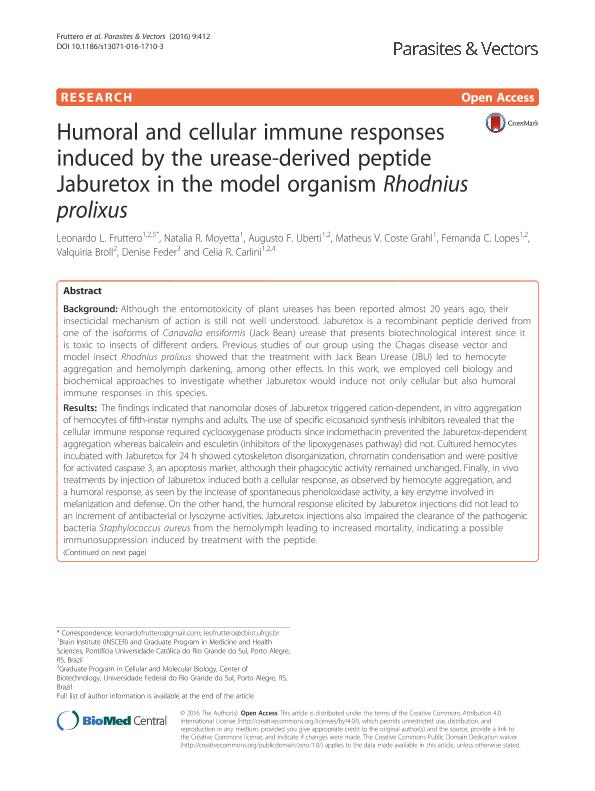Mostrar el registro sencillo del ítem
dc.contributor.author
Fruttero, Leonardo Luis

dc.contributor.author
Moyetta, Natalia Rita

dc.contributor.author
Uberti, Augusto F.
dc.contributor.author
Grahl, Matheus V. Coste
dc.contributor.author
Lopes, Fernanda C.
dc.contributor.author
Broll, Valquiria
dc.contributor.author
Feder, Denise
dc.contributor.author
Carlini, Celia R.
dc.date.available
2018-08-10T17:52:26Z
dc.date.issued
2016-07
dc.identifier.citation
Fruttero, Leonardo Luis; Moyetta, Natalia Rita; Uberti, Augusto F.; Grahl, Matheus V. Coste; Lopes, Fernanda C.; et al.; Humoral and cellular immune responses induced by the urease-derived peptide Jaburetox in the model organism Rhodnius prolixus; BioMed Central; Parasites and Vectors; 9; 1; 7-2016
dc.identifier.uri
http://hdl.handle.net/11336/54980
dc.description.abstract
Although the entomotoxicity of plant ureases has been reported almost 20 years ago, their insecticidal mechanism of action is still not well understood. Jaburetox is a recombinant peptide derived from one of the isoforms of Canavalia ensiformis (Jack Bean) urease that presents biotechnological interest since it is toxic to insects of different orders. Previous studies of our group using the Chagas disease vector and model insect Rhodnius prolixus showed that the treatment with Jack Bean Urease (JBU) led to hemocyte aggregation and hemolymph darkening, among other effects. In this work, we employed cell biology and biochemical approaches to investigate whether Jaburetox would induce not only cellular but also humoral immune responses in this species. Results: The findings indicated that nanomolar doses of Jaburetox triggered cation-dependent, in vitro aggregation of hemocytes of fifth-instar nymphs and adults. The use of specific eicosanoid synthesis inhibitors revealed that the cellular immune response required cyclooxygenase products since indomethacin prevented the Jaburetox-dependent aggregation whereas baicalein and esculetin (inhibitors of the lipoxygenases pathway) did not. Cultured hemocytes incubated with Jaburetox for 24 h showed cytoskeleton disorganization, chromatin condensation and were positive for activated caspase 3, an apoptosis marker, although their phagocytic activity remained unchanged. Finally, in vivo treatments by injection of Jaburetox induced both a cellular response, as observed by hemocyte aggregation, and a humoral response, as seen by the increase of spontaneous phenoloxidase activity, a key enzyme involved in melanization and defense. On the other hand, the humoral response elicited by Jaburetox injections did not lead to an increment of antibacterial or lysozyme activities. Jaburetox injections also impaired the clearance of the pathogenic bacteria Staphylococcus aureus from the hemolymph leading to increased mortality, indicating a possible immunosuppression induced by treatment with the peptide. Conclusions: In our experimental conditions and as part of its toxic action, Jaburetox activates some responses of the immune system of R. prolixus both in vivo and in vitro, although this induction does not protect the insects against posterior bacterial infections. Taken together, these findings contribute to the general knowledge of insect immunity and shed light on Jaburetox's mechanism of action.
dc.format
application/pdf
dc.language.iso
eng
dc.publisher
BioMed Central

dc.rights
info:eu-repo/semantics/openAccess
dc.rights.uri
https://creativecommons.org/licenses/by-nc-sa/2.5/ar/
dc.subject
Cellular Immunity
dc.subject
Humoral Immunity
dc.subject
Jaburetox
dc.subject
Rhodnius Prolixus
dc.subject
Ureases
dc.subject.classification
Otras Ciencias Biológicas

dc.subject.classification
Ciencias Biológicas

dc.subject.classification
CIENCIAS NATURALES Y EXACTAS

dc.title
Humoral and cellular immune responses induced by the urease-derived peptide Jaburetox in the model organism Rhodnius prolixus
dc.type
info:eu-repo/semantics/article
dc.type
info:ar-repo/semantics/artículo
dc.type
info:eu-repo/semantics/publishedVersion
dc.date.updated
2018-08-08T18:17:35Z
dc.identifier.eissn
1756-3305
dc.journal.volume
9
dc.journal.number
1
dc.journal.pais
Reino Unido

dc.journal.ciudad
Londres
dc.description.fil
Fil: Fruttero, Leonardo Luis. Pontificia Universidade Católica do Rio Grande do Sul; Brasil. Consejo Nacional de Investigaciones Científicas y Técnicas. Centro Científico Tecnológico Córdoba. Centro de Investigaciones en Bioquímica Clínica e Inmunología; Argentina
dc.description.fil
Fil: Moyetta, Natalia Rita. Pontificia Universidade Católica do Rio Grande do Sul; Brasil. Consejo Nacional de Investigaciones Científicas y Técnicas. Centro Científico Tecnológico Córdoba. Centro de Investigaciones en Bioquímica Clínica e Inmunología; Argentina
dc.description.fil
Fil: Uberti, Augusto F.. Pontificia Universidade Católica do Rio Grande do Sul; Brasil
dc.description.fil
Fil: Grahl, Matheus V. Coste. Pontificia Universidade Católica do Rio Grande do Sul; Brasil
dc.description.fil
Fil: Lopes, Fernanda C.. Pontificia Universidade Católica do Rio Grande do Sul; Brasil
dc.description.fil
Fil: Broll, Valquiria. Universidade Federal do Rio Grande do Sul; Brasil
dc.description.fil
Fil: Feder, Denise. Universidade Federal Fluminense; Brasil
dc.description.fil
Fil: Carlini, Celia R.. Pontificia Universidade Católica do Rio Grande do Sul; Brasil
dc.journal.title
Parasites and Vectors

dc.relation.alternativeid
info:eu-repo/semantics/altIdentifier/url/https://parasitesandvectors.biomedcentral.com/articles/10.1186/s13071-016-1710-3
dc.relation.alternativeid
info:eu-repo/semantics/altIdentifier/doi/http://dx.doi.org/10.1186/s13071-016-1710-3
Archivos asociados
